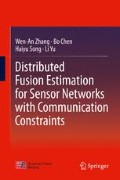Abstract
It is known that the WSNs are usually severely constrained in energy, and energy-efficient methods are thus important for WSN-based estimation to reduce energy consumption and to prolong network life. Several energy-efficient estimation methods have been available in the literature, such as the quantization method [1–6] and the data-compression method [1, 7–10]. The main idea in quantization and compression is to reduce the size of a data packet and thus to reduce energy consumption in transmitting and receiving packets, and they can be called as the packet size-based energy-efficient estimation methods. Actually, a useful and straightforward approach to saving energy is to slow down the information transmission rate in the sensors, for example, the sensors may measure and transmit measurements with a period that is several times of the sampling period.
Access this chapter
Tax calculation will be finalised at checkout
Purchases are for personal use only
References
Fang J, Li HB (2008) Distributed adaptive quantization for wireless sensor networks: from delta modulation to maximum likelihood. IEEE Trans Signal Process 56(10):5246–5257
Fang J, Li H (2009) Hyperplane-based vector quantization for distributed estimation in wireless sensor networks. IEEE Trans Inf Theory 55:5682–5699
Sun SL, Lin JY, Xie LH, Xiao WD (2007) Quantized Kalman filtering. In: The 22nd IEEE international symposium on intelligent control, Singapore, pp 7–12
Zhou Y, Li JX (2009) Quantized measurement fusion for target tracking in wireless sensor networks. In: In the joint 48th IEEE conference on decision and control and the 28th Chinese control conference, Shanghai, pp 6835–6840
Ghasemi N, Dey S (2008) Power-efficient dynamic quantization for multisensor HMM state estimation over fading channels. In: The 3rd international symposium on communications, control and signal processing, St Julians, pp 1553–1558
Ribeiro A, Giannakis GB, Roumeliotis SI (2006) SOI-KF: distributed Kalman filtering with low-cost communications using the sign of innovations. IEEE Trans Signal Process 54(12):4782–4795
Schizas ID, Giannakis GB, Luo ZQ (2007) Distributed estimation using reduced-dimensionality sensor observations. IEEE Trans Signal Process 55(8):4284–4299
Zhu H, Schizas ID, Giannakis GB (2009) Power-efficient dimensionality reduction for distributed channel aware Kalman tracking using WSNs. IEEE Trans Signal Process 57(8):3193–3207
Zhu Y, Song E, Zhou J, You Z (2005) Optimal dimensionality reduction of sensor data in multisensor estimation fusion. IEEE Trans Signal Process 53(3):1631–1639
Chen HM, Zhang KS, Li XR (2004) Optimal data compression for multisensor target tracking with communication constraints. In: Proceedings of the 43th IEEE conference on decision and control, Atlantis, pp 8179–8184
Liang Y, Chen TW, Pan Q (2009) Multi-rate optimal state estimation. Int J Control 82(11):2059–2076
Liang Y, Chen TW, Pan Q (2010) Multi-rate stochastic \(H_{\infty }\) filtering for networked multi-sensor fusion. Automatica 46(2):437–444
Olfati-Saber R (2005) Distributed Kalman filter with embedded consensus filters. In: Proceedings of the 44th IEEE conference decision and control, Sevilla, pp 8179–8184
Zhang WA, Yu L, Song HB (2009) \(H_{\infty }\) filtering of networked discrete-time systems with random packet losses. Inf Sci 179(22):3944–3955
Anderson BDO, Moore JB (1979) Optimal filtering. Prentice-Hall, Englewood Cliffs
Cattivelli FS, Sayed AH (2010) Diffusion strategies for distributed Kalman filtering and smoothing. IEEE Trans Autom Control 55(9):2069–2084
Sun SL, Deng ZL (2004) Multi-sensor optimal information fusion Kalman filter. Automatica 40(6):1017–1023
Author information
Authors and Affiliations
Rights and permissions
Copyright information
© 2016 Science Press, Beijing and Springer Science+Business Media Singapore
About this chapter
Cite this chapter
Zhang, WA., Chen, B., Song, H., Yu, L. (2016). Multi-rate Kalman Fusion Estimation for WSNs. In: Distributed Fusion Estimation for Sensor Networks with Communication Constraints. Springer, Singapore. https://doi.org/10.1007/978-981-10-0795-8_2
Download citation
DOI: https://doi.org/10.1007/978-981-10-0795-8_2
Published:
Publisher Name: Springer, Singapore
Print ISBN: 978-981-10-0793-4
Online ISBN: 978-981-10-0795-8
eBook Packages: EngineeringEngineering (R0)

